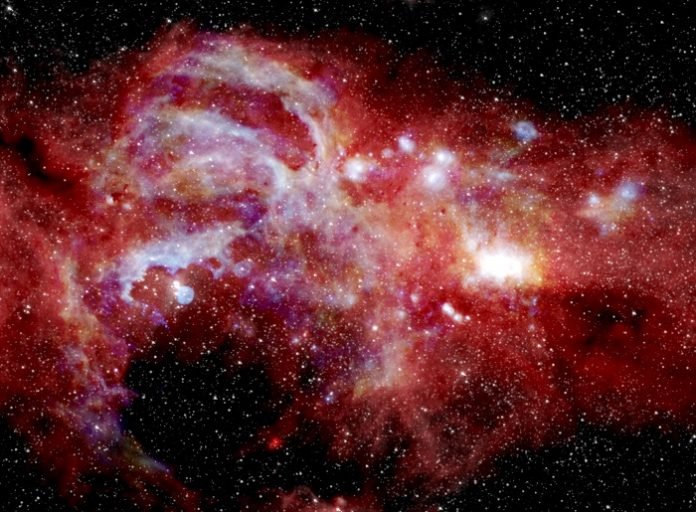
A new panoramic image based on data captured by NASA’s Stratospheric Observatory for Infrared Astronomy (SOFIA) shows the bustling center of our galaxy like it has never been seen before.
SOFIA is an airborne observatory that flies up into the lower regions of the stratosphere, about 40,000 feet above Earth, to capture infrared images of the cosmos.
At these heights, the flying telescope can bypass a portion of Earth’s atmosphere that blocks a significant amount of infrared light.
From July 1 to July 11 of 2019, researchers led by Matt Hankins, a postdoctoral scholar at Caltech, took SOFIA on several flights to capture new infrared views of the brightest portions of the center of our galaxy.
Previous infrared telescopes were unable able to capture these regions because the intense brightness led to overexposed images. Unlike those telescopes, SOFIA can take short exposures, reducing the chances of oversaturation.
“We are filling in the most active star-forming regions of the galactic center that were missing in previous images,” says Hankins, principal investigator of the program to observe the galactic center with SOFIA’s FORCAST (Faint Object Infrared Camera for the SOFIA Telescope) instrument.
Hankins works in the group of Mansi Kasliwal (MS ’07, PhD ’11), assistant professor of astronomy at Caltech.
Hankins rode on SOFIA for a total of eight observing runs. During the flights, he monitored incoming data to make sure they looked as expected.
Because winds and other factors can impact the length of each flight leg, last-minute adjustments to the observing plan can be necessary.
“That’s the nature of the beast of having a flying observatory,” he says. “When the mission director says the plane has to turn to focus on the next target, you have to move on. The whole operation is highly choreographed and planned down to the second, but last-minute changes can still occur.”
The new panoramic image shows SOFIA data taken at mid-infrared wavelengths of 25 and 37 microns (colored green and blue, respectively) overlaid on previous imagery taken by the Herschel Space Observatory, a European infrared mission that shut down in 2013, and by NASA’s Spitzer Space Telescope, an infrared mission scheduled to be decommissioned on January 30, 2020.
The SOFIA maps reveal dust that has been heated by many of the most massive stars in the region, including some that are up to 100 times as massive as our sun. Several of these dust features had not been fully resolved in previous infrared maps, so the new maps allow researchers to study these bright sources at a level of detail not possible before.
“We still don’t understand how massive stars form in this incredibly dense region of our galaxy,” says Hankins. “While the galactic center has numerous massive stars that are seen in the SOFIA maps, theory suggests the region should have many more stars than are presently known. Examining this discrepancy is an important aim of our study.”
Like other infrared telescopes, SOFIA can pierce through the cool dust lying between us and the center of our galaxy. Because visible-light telescopes cannot see through the dust, their images reveal only dark clouds. By observing at mid-infrared wavelengths, SOFIA is uniquely positioned to not only see through the cool dust but also to pick up the signatures of warm dust buried in the galactic center.
Hankins also says that this galactic map will serve as a guide for NASA’s upcoming James Webb Space Telescope (JWST), scheduled to launch in 2021. “Planning JWST observations of infrared light in this region will be very difficult without the SOFIA data. These maps will be crucial for studying young, massive stars in the center of our galaxy in the JWST era,” he says.
An overview paper highlighting the initial results has been submitted for publication to The Astrophysical Journal. The full calibrated data set is currently available to astronomers worldwide for further research via the SOFIA Legacy Program.
Written by Whitney Clavin.



